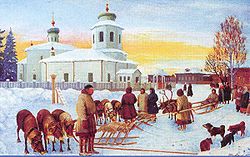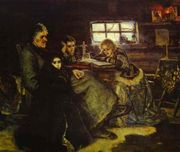
Beryozovo
Encyclopedia


Urban-type settlement
Urban-type settlement ; , selyshche mis'koho typu ) is an official designation for a type of locality used in some of the countries of the former Soviet Union...
) and the administrative center of Beryozovsky District
Beryozovsky District, Khanty-Mansi Autonomous Okrug
Beryozovsky District is one of nine districts of Khanty-Mansi Autonomous Okrug — Yugra, Russia, located in the northwestern part of the autonomous okrug, on the left bank of meridional part of the Ob River within the limits of North Sosva altitudes and the east slope of the North and Pre-Polar Ural...
of Khanty–Mansi Autonomous Okrug, Russia
Russia
Russia or , officially known as both Russia and the Russian Federation , is a country in northern Eurasia. It is a federal semi-presidential republic, comprising 83 federal subjects...
, located on the Ob River
Ob River
The Ob River , also Obi, is a major river in western Siberia, Russia and is the world's seventh longest river. It is the westernmost of the three great Siberian rivers that flow into the Arctic Ocean .The Gulf of Ob is the world's longest estuary.-Names:The Ob is known to the Khanty people as the...
. Population:
It is situated on three hills on the left bank of the Northern Sosva River, at its junction with the Ob River
Ob River
The Ob River , also Obi, is a major river in western Siberia, Russia and is the world's seventh longest river. It is the westernmost of the three great Siberian rivers that flow into the Arctic Ocean .The Gulf of Ob is the world's longest estuary.-Names:The Ob is known to the Khanty people as the...
. It has more than once suffered from conflagration
Conflagration
A conflagration or a blaze is an uncontrolled burning that threatens human life, health, or property. A conflagration can be accidentally begun, naturally caused , or intentionally created . Arson can be accomplished for the purpose of sabotage or diversion, and also can be the consequence of...
s for example, in 1719 and 1808. The yearly mean temperature is +4°C, the low being −44°C.
History
There was some ill-documented Russian trade in the area before the Russian conquest of SiberiaRussian conquest of Siberia
The Russian conquest of Siberia took place in the 16th and 17th centuries, when the Siberian Khanate had become a loose political structure of vassalages which were becoming undermined by the activities of Russian explorers who, though numerically outnumbered, pressured the various family-based...
. Beryozovo was founded in 1593 on the Northern Sosva route across the Ural Mountains
Ural Mountains
The Ural Mountains , or simply the Urals, are a mountain range that runs approximately from north to south through western Russia, from the coast of the Arctic Ocean to the Ural River and northwestern Kazakhstan. Their eastern side is usually considered the natural boundary between Europe and Asia...
to the fur-rich Mangazeya
Mangazeya
Mangazeya was a Northwest Siberian trans-Ural trade colony and later city in the 16-17th centuries. Founded in 1600, it was situated on the Taz River, between the lower courses of the Ob and Yenisei Rivers flowing into the Arctic Ocean....
region. It was besieged by the Ostyaks
Khanty people
Khanty / Hanti are an indigenous people calling themselves Khanti, Khande, Kantek , living in Khanty-Mansi Autonomous Okrug, a region historically known as "Yugra" in Russia, together with the Mansi. In the autonomous okrug, the Khanty and Mansi languages are given co-official status with Russian...
in 1592, 1697, and 1608. It grew into a town of Beryozov in Tobolsk Governorate. By the late 17th century most trade had shifted south to Verkhoturye
Verkhoturye
Verkhoturye is a historic town and the administrative center of Verkhotursky District of Sverdlovsk Oblast, Russia, located in the middle Ural Mountains on the left bank of the Tura River north of Yekaterinburg. Population: 7,815 Verkhoturye is a historic town and the administrative center of...
.
In the mid-18th century, gold was discovered at Beryozovo—Siberia's first important gold mine. It was worked by serfs and convicts under primitive conditions and produced about 400 ounces a year (by the mid-19th century the gold sands further east were producing 600,000 ounces per year). In the 1960s, gas fields were discovered near its lower course causing a major population growth in the area. Transport is by river boat or ice road.
Prince Menshikov, the favorite of Peter the Great and Catherine I
Catherine I of Russia
Catherine I , the second wife of Peter the Great, reigned as Empress of Russia from 1725 until her death.-Life as a peasant woman:The life of Catherine I was said by Voltaire to be nearly as extraordinary as that of Peter the Great himself. There are no documents that confirm her origins. Born on...
, died here in exile
Exile
Exile means to be away from one's home , while either being explicitly refused permission to return and/or being threatened with imprisonment or death upon return...
in 1729. In 1730, his enemy and rival, Prince Dolgoruky
Vasily Lukich Dolgorukov
Prince Vasiliy Lukich Dolgorukov was a Russian diplomat and minister who was the most powerful man in the country in the later years of Peter II's reign....
, was interned here with his family; and in 1742 General Ostermann
Andrei Osterman
Count Andrey Ivanovich Osterman was a German-born Russian statesman who came to prominence under Tsar Peter I of Russia and served until the accession of the Tsesarevna Elizabeth. His foreign policy was based upon the Austrian alliance...
was sent to Beryozov with his wife and died there in 1747. It has a cathedral, near which lie buried Mary Menshikova (a daughter of Aleksandr Menshikov, who attempted to make her betrothed to tsar Peter II
Peter II of Russia
Pyotr II Alekseyevich was Emperor of Russia from 1727 until his death. He was the only son of Tsarevich Alexei Petrovich, son of Peter I of Russia by his first wife Eudoxia Lopukhina, and Princess Charlotte, daughter of Duke Louis Rudolph of Brunswick-Lüneburg and sister-in-law of Charles VI,...
) and some of the Dolgorukov
Dolgorukov
Dolgoroukov is the name of a princely Russian family Dolgorukovs of Rurikid stock. Descendants of Mikhail of Chernigov, they took their name from one prince of Obolensk, whose sobriquet was Dolgorouky, or "Long-Armed" in Russian, alluding their lineage to the ancient Persian monarchy. Among its...
s. In the 19th century, Beryozov was a place of exile for many of the Decembrists. In the 20th century, the Tsarist regime banished a few revolutionaries here as well.
In 1907, Trotsky while on his way to exile in Obdorsk escaped from Berezov on February 12/13. It had taken 33 days by train and horse to get from St Petersburg. He mentions Prince Menshikov had been in exile here.
External links
- Beryozovo Museum (mostly in Russian with some English)

